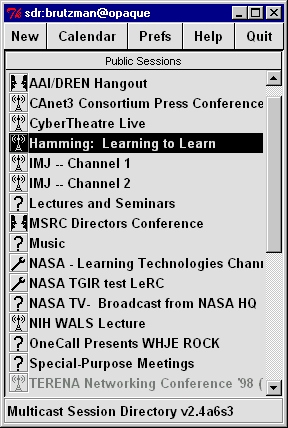The Art of Doing SCIENCE and Engineering: Learning to Learn
Richard W. Hamming (1915-1998)
Overview
The late Richard W. Hamming made numerous fundamental
contributions to mathematics and computer science.
He passed away suddenly on January 7, 1998.
For many years he taught a capstone course on the future
of science and engineering at the Naval Postgraduate School (NPS).
This course is extremely stimulating. Many people think it is the most
important course they have ever taken. Dr. Hamming's observations on
learning and the conduct of scientific inquiry are profound, far-reaching
and practical. Because he discusses a large number of subjects which
he helped develop first-hand, this course has sometimes been called
"Hamming on Hamming." However, Dr. Hamming was always insistent that
he only used first-person examples because they best achieved his true goal:
showing people how they might learn to learn.
In 1995, Tracey Emswiler and R. Jon Bigelow recorded the full lecture series
and transmitted the live audio and video streams over the Internet's
Multicast Backbone (MBone). This was the first complete global multicast
of a full-quarter academic class. About thirty students attended
the class locally, while Internet attendance ranged from five to forty.
Mike Tiddy and Mark Glover wrote follow-on theses about this course which showed
how multicast distribution of this video material might best be accomplished
to support distance learning.
In 1998 Simon Goerger, Rob Jezek, Mark Evans and Steve Murley
succeeded in recording all 30 lectures for on-demand playback
using Wieland Hofhelder's MBone VCR On Demand (MVoD) software.
We are now ready for the final steps in preparing this thought-provoking
material for use as a viable distance-learning course.
If you are interested in taking the class,
please send mail to Don Brutzman at
brutzman@nps.navy.mil.
Textbook
Hamming, Richard W., The Art of Doing SCIENCE and Engineering: Learning to Learn,
Gordon and Breach Science Publishers, Amsterdam B.V, The Netherlands, 1997.
From the cover:
This book is intended to instill in the reader a style of thinking
that will enhance his ability to function as a problem solver of complex technical issues.
A collection of stories about the author's participation in significant discoveries,
it relates how those discoveries came about and, most importantly, provides analysis about
the thought processes and reasoning that took place as the author and his associates progressed
through engineering problems.
Dr. Hamming believes that highly effective thinking is an art that engineers and scientists
can be taught to develop. By presenting actual experiences and analyzing them as they are
described, he conveys the developmental thought processes employed and shows that a style of
thinking that leads to successful results is something that can be learned. Along with
spectacular successes, the author also shows how failures contributed to shaping the thought process.
For several years this material has been taught to graduate students at the U.S. Naval Postgraduate
School in Monterey, California in preparation for their military careers. The volume
is written in a very informal conversational style and can be read in whole or in part. Although
mathematics are used to illustrate clearly how discoveries were made and problems solved,
the book can be read and its benefit derived without the mathematics.
About the author. Richard W. Hamming spent the majority of his career at AT&T Bell Laboratories
in Murray Hill, New Jersey, where he built his reputation with discoveries in coding and information
theory, digital filtering, and numerical methods. Every year the Institute of Electrical and
Electronic Engineers (IEEE) presents the Richard W. Hamming Medal, an award for
"exceptional contributions to information sciences and systems."
Course Objectives
We will view all 30 lectures via the campus MBone individually over the network,
at a rate of three per week. We will also meet weekly to discuss the material
and upgrade the website.
There is approximately one hour of reading from the textbook per hour of video lecture.
NPS-Wide MBone Announcement
[Here is our original announcement.]

|
On the left is a picture of typical program listings available via the sdr session directory reporting tool.
Click on the right image to see the full-size Hamming: Learning to Learn session description.
A
copy of the session announcement file
illustrates how the
Session Description Protocol (SDP)
is used to convey to receivers the packetization scheme used, the media
data encoding format and parameters for the media encoding format.
The SDP RFC is written by Mark Handley & Van Jacobson and is available at
ftp://ftp.isi.edu/in-notes/rfc2327.txt
The time-to-live (ttl) value for this session announcement will be adjusted
from NPS-wide to global (i.e. worldwide) distribution
after this quarter's beta test of course content is complete.
|

|
References
Hofhelder, Wieland, MBone VCR on Demand (MVoD) Website, September 1998. Video-on-demand support using Java applet client and Java server software.
Available at
www.informatik.uni-mannheim.de/informatik/pi4/projects/MVoD/
Finlayson, Ross, LiveNetwork's Windows/Unix MBone software Multikit at
www.lvn.com/multikit
Almeroth, Kevin, The Interactive Multimedia Jukebox (IMJ) Website, September 1998. Video-on-demand support using HTML client and cgi-bin server software.
Available at
imj.gatech.edu
Glover, Mark P., Internetworking: Distance Learning "To Sea" via
Desktop Videoconferencing Tools and IP Multicast Protocols,
Master's Thesis, Naval Postgraduate School, Monterey California,
March 1998. Primary advisor Rex Buddenberg. Available at
web.nps.navy.mil/~seanet/Distlearn/cover.htm
Tiddy, Michael E., Internetworking: Economical Storage and Retrieval
of Digital Audio and Video for Distance Learning,
Master's Thesis, Monterey California, June 1996.
Available at
www.stl.nps.navy.mil/~iirg/tiddy/
Emswiler, Tracey, Internetworking: Using the Multicast Backbone (MBone) for Distance Learning, Master's Thesis, Naval Postgraduate School, Monterey
California, September 1995.
Bigelow, Randall J., Internetworking: Planning and Implementing a Wide-Area
Network (WAN) for K-12 Schools, Master's Thesis, Naval Postgraduate School,
Monterey California, June 95. Describes in detail how local-area networks
(LANs) and WANs were implemented to connect two dozen K-12 schools to the
Internet. Available at http://www.stl.nps.navy.mil/~rjbigelo
Macedonia, Michael R. and Brutzman, Donald P., "MBone Provides Audio and Video
Across the Internet," IEEE COMPUTER, vol. 27 no. 4, April 1994, pp. 30-36.
Available at
ftp://taurus.cs.nps.navy.mil/pub/i3la/mbone.html
or
mbone.pdf
Uniform Resource Locator (URL) for this page is
http://web.nps.navy.mil/~brutzman/hamming/hamming.html
(14 September 2000)
(official disclaimer)

